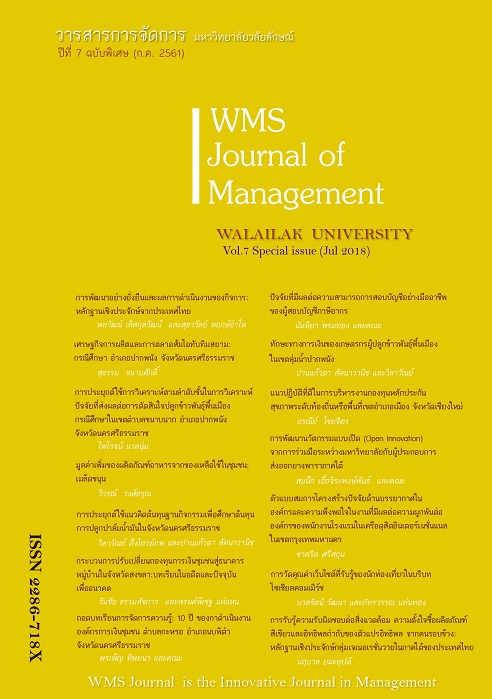Sustainable Development and Firm Performance: Evidence from Thailand
Main Article Content
Abstract
The sustainability framework shifts the firm’s management paradigm from simply maximising shareholders’ wealth to also considering the wider interests of stakeholders as well as environmental and social developments. This study aims to examine whether sustainable development has a significant link with firm performance. Since the Stock Exchange of Thailand has just launched the list of firms that were announced as part of the “Thai Sustainability Investment (THSI)” scheme in 2015, we use the firms has passed the sustainability criteria as the representative of firms with superior sustainable developme
The size-matched firms have not passed these criteria are used as a comparative group. The matched pair design is employed to reduce the heteroscedasticity between the groups. The total sample was finalised as 122 firms: 66 from the Thai Sustainability Investment list, and 56 with a similar size, based on market capitalisation. To measure firm performance, we use both accounting base (return on asset – ROA and return on equity – ROE) and economic base (the economic value added – EVA). The results show no differences in performance between the Thai Sustainability Investment firms and the matched ones. However, our result does not discourage the firms or investors to ignore the importance of corporate social responsible (CSR). Rather, the costs of CSR are immediate but the benefits – image and reputation are not often realised in a few years. In addition, the cost incurred from the explicit claims may offset by the gain from CSR.
Article Details
References
Alexander, G.J. and Buchholz, R. A. (1978). Corporate social responsibility and stock market performance. Academy of Management Journal, 21(3). 479-486.
Barnett, M.L. (2007). Stakeholder influence capacity and the variability of financial returns to corporate social responsibility. Academy of Management Review, 32(3). 794-816.
Bauer, R., Frijns, B., Otten, R. and Tourani-Rad, A. (2008). The impact of corporate governance on corporate performance: Evidence from Japan. Pacific-Basin Finance Journal, 16(3). 236-251.
Bhagat, S. and Bolton, B. (2008). Corporate governance and firm performance. Journal of Corporate Finance, 14(3). 257-273.
Cortez, M.A. and Cudia, C.P. (2011). Sustainability and firm performance: A case study of Japanese electronics companies. Ritsumeikan International Affairs, 10(2). 321-340.
De Groot, C. G. M. and Verschoor, W. F. C. (2002). Further evidence on Asian stock return behavior. Emerging Markets Review, 3(2). 179-193.
Dimitropoulos, P.E. and Vrondou, O. (2015). Corporate social responsibility and firm value in the sport recreation sector: A review. Business Management and Strategy, 6(2). 28-43.
Eccles, R.G., Ioannou, I. and Serafeim, G. (2014). The Impact of corporate sustainability on organizational processes and performance. Management Science, 60(11). 2835-2857
Fu, F. (2010). Overinvestment and the operating performance of SEO firms. Financial Management, 39(1). 249-272.
Goyal, P., Rahman, Z. and Kazmi, A.A. (2013). Corporate sustainability performance and firm performance research: Literature review and future research agenda. Management Decision, 51(2). 361-379.
Hansen, G.S. and Wernerfelt, B. (1989). Determinants of firm performance: the relative importance of economic and organizational factors. Strategic Management Journal, 10(5). 399-411.
Hertzel, M., Lemmon, M., Linck, J. S. and Rees, L. (2002). Long-run performance following private placements of equity. Journal of Finance, 57(6). 2595-2617.
Jensen, M.C. and Meckling, W.H. (1976). Theory of the firm: managerial behavior, agency costs and ownership structure. Journal of Financial Economics, 3(4). 305-360.
Kang, J.K. and Shivdasani, A. (1995). Firm performance, corporate governance, and top executive turnover in Japan. Journal of Financial Economics, 38(1). 29-58.
Limpaphayom, P. and Ngamwutikul, A. (2004). Ownership structure and post-issue operating performance of firms conducting seasoned equity offerings in Thailand. Journal of Economics and Finance, 28(3). 307-332.
Lopez, M.V., Garcia, A. and Rodriguez, L. (2007). Sustainable development and corporate performance: A study based on the Dow Jones Sustainability Index. Journal of Business Ethics, 75(3). 285–300.
McGuire, J.B., Sundgren, A. and Schneeweis, T. (1988). Corporate social responsibility and firm financial performance. The Academy of Management Journal, 31(4). 854-872.
Nelling, E. and Webb, E. (2009). Corporate social responsibility and financial performance: the ‘‘virtuous circle’’ revisited. Review of Quantitative Finance and Accounting, 32(2). 197-209.
Ngwakwe, C.C. (2008). Environmental responsibility and firm performance: Evidence from Nigeria. International Journal of Social, Behavioral, Educational, Economic, Business and Industrial Engineering, 2(10). 1055-1062.
Nor, N.M., Bahari, N.A.S., Adnan, N.A., Qamarul, S.M., Kamal, A.S. and Ali, I.M. (2016). The effects of environmental disclosure on financial performance in Malaysia. Procedia Economics and Finance, 35. 117-126.
Ruangviset, J., Jiraporn, P. and Kim, J.C. (2014). How does corporate governance influence corporate social responsibility? Procedia - Social and Behavioral Sciences, 143. 1055-1057.
Sarumpaet, S. (2005). The relationship between environmental performance and financial performance of Indonesian companies. Jurnal Akuntansi dan Keuangan, 7(2). 89-96.
Servaes, H. and Tamayo, A. (2013). The impact of corporate social responsibility on firm value: The role of customer awareness. Management Science, 59(5). 1045–1061.
Singal, M. (2014). The link between firm financial performance and investment in sustainability initiatives. Cornell Hospitality Quarterly, 55(1). 19–30.
Stewart, G.B. (1991). The Quest for value: A guide for senior managers. First Ed., New York: Harper Business.
Tsoutsoura, M. (2004). Corporate social responsibility and financial performance. Working Paper Series, available online via: https://escholarship.org/uc/item/111799p2, retrieved on 18 May 2016.
Udayasankar, K. (2008). Corporate social responsibility and firm size. Journal of Business Ethics, 83(2). 167-175.
Wang, G.Y. and Hsu, W-H.L. (2011). Corporate social responsibility and firm performance. Retrieved 18 May 2016. From https://ieeexplore.ieee.org/stamp/stamp.jsp?tp=&arnumber=6121164

